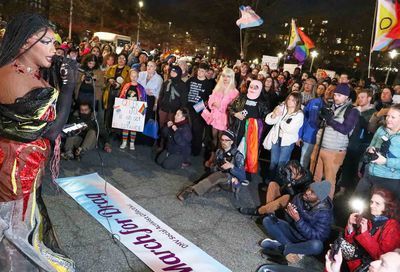Blurred Vision
Spy Kids 3D
The gimmick worked.
The addition of 3D to the apparently annual Spy Kids series of movies brought the film in at number one last weekend — handily clobbering Seabiscuit and the sequel to Tomb Raider — with a total box office of $32.5 million, nearly double what Spy Kids 2 debuted at a year ago. That’s good news for Dimension Films, bad news for the general public, as it might trigger a green light for a fourth Spy Kids movie, which is something the world really, really, really, really, REALLY doesn’t need.
The 3D effects are about all the botch-job Spy Kids 3D: Game Over has going for it. The narrative, set mostly within the confines of a cluttered and confusing video game environment, is a random smattering of events that ultimately make no sense whatsoever. The performances are so persistently flat that they attain dimension only from the red-blue glasses the audience is obliged to wear throughout much of the film.
 |
Yes, red-blue. This is the old style 3D process, an effect that works fairly well, but is hardly as impressive as 3D created with the more expensive polarized-lens process. Director Robert Rodriguez clearly chose the red-blue lens system for one of two reasons: A) they’re cheap and disposable, and B) because the eventual DVD release of the film would be 3D-free without them. And we can’t have that, can we now?
Rodriguez, who has helmed all three films and who is, in his own right, one of the better action directors working today, is operating on the fumes of fumes here. The series — so vibrant, appealing and clever when it hit screens in 2001 — began to show signs of wear last summer, though it still hadn’t plunged to the level of abysmal. Spy Kids 3D takes that plunge, headfirst. Workmanlike and pointless, the movie is drained of all the charm that made the original such a whiz-bang delight. Only in the final minutes, as the Cortez family (along with a reunion of all the principle characters from the prior films) bands together to fight a team of giant robots — does Spy Kids 3D offer up even the tiniest morsel of tongue-in-cheek refreshment.
When we meet up with Juni (Daryl Sabara) at the film’s start, we learn he’s left the junior division of the OSS, the super-secret government agency for which his family works as super-secret spies. “I was burned by the agency, ” he says in a morose voice-over, but we never learn what awful thing happened to turn the youngster away from his life of heroics.
Juni springs back into action upon learning his sister, Carmen (Alexa Vega), is perilously trapped on the fourth level of a virtual reality game created by the maniacal Toymaker (Sylvester Stallone), himself imprisoned by the OSS in the game’s core program. (Huh? What? Huh? Exactly.) The game is scheduled to go online in a matter of hours, at which point it will overtake the minds of the millions of game-playing kids who reach its unbeatable fifth level.
With the help of his grandfather (Ricardo Montalban, looking as though he’s been cut-and-pasted into the film from a remote location, the Wrath of Kahn, perhaps) and a trio of beta-tester boys, Juni locates Carmen (so late in the film, I might add, that the film’s title might as well have been stated in the singular), and enters the vaunted fifth level, where nothing much happens other than a quick flick of an off-switch and a less-than-great escape back into the real world. At which point “GLASSES OFF ” blinks and blazes across the screen.
Rodriguez, who also wrote the film, is clearly a movie-lover, and he references a smattering of films, including Tron, Halloween 3, and the 3D craze of the fifties. By setting the film in a video game, in which anything can and does happen, often with an infuriating arbitrariness, he takes the lazy way out. There is no narrative construct to the movie, only bombast and special effects, most of which have been done on the cheap (what’s the matter, Harvey, didn’t want to shell out a few extra bucks?). Despite one or two noteworthy action sequences, Spy Kids 3D is as messy as your typical eight-year-old boy’s bedroom. Only kids will be razzle-dazzled by the 3D, used throughout as a perpetual distraction. Adults, on the other hand, ought to bring a handful of Excedrin for the throbbing headache that comes after a half-hour of “GLASSES ON ” time.
It’s a mystery why Antonio Banderas gets top billing, since he’s utilized for all of about seven minutes. Cameos from George Clooney, Elijah Wood, Steve Buscemi (perched aboard a flying pig, no less), and bit parts by Salma Hayek and King of the Hill‘s Mike Judge, don’t add anything of value, and everyone acts as though they’d been instructed to say their lines in the loudest, blandest fashion possible, as though they were reading aloud to infants. Or cats.
No one, however, fares worse than 11-year-old Sabara, so cute and cuddly in the first two films and now proving himself to be the kind of child actor who should start thinking hard about what he really wants to do with his life. (On the other hand, if ever there were an actor primed to play the little wooden boy, PinocchioÂ…)
Actually, there is one performance worse than Sabara’s: Stallone’s. The diagonal-lipped “actor ” gets a chance to play several virtual versions of the Toymaker, including a Hippie and a character that looks like something out of WWI Germany, and the result is like something out of a Saturday Night Live sketch during its Jean Doumanian period. Stallone’s performance is an exercise in self-humiliation, but the actor doesn’t seem to mind, since he’s never really had any respect for the moviegoing public. If he had, he would have remained in the world from whence he came: soft-core porn.
Support Metro Weekly’s Journalism
These are challenging times for news organizations. And yet it’s crucial we stay active and provide vital resources and information to both our local readers and the world. So won’t you please take a moment and consider supporting Metro Weekly with a membership? For as little as $5 a month, you can help ensure Metro Weekly magazine and MetroWeekly.com remain free, viable resources as we provide the best, most diverse, culturally-resonant LGBTQ coverage in both the D.C. region and around the world. Memberships come with exclusive perks and discounts, your own personal digital delivery of each week’s magazine (and an archive), access to our Member's Lounge when it launches this fall, and exclusive members-only items like Metro Weekly Membership Mugs and Tote Bags! Check out all our membership levels here and please join us today!




















